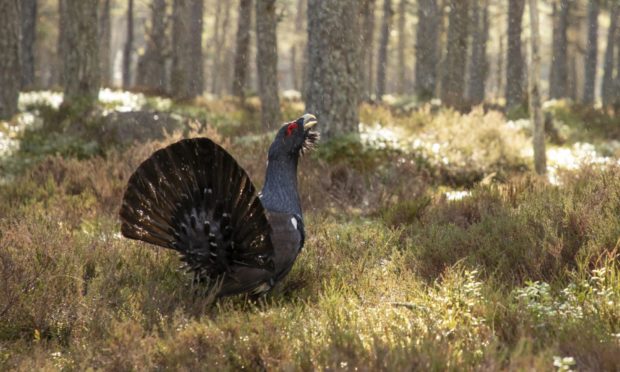DNA from over 1,000 capercaillie feathers collected in the Cairngorms – the last remaining stronghold for the species in the UK – will be analysed in a bid to save the rare bird from extinction.
With potentially less than 1,000 birds left, it is feared the population could be “stuck in a deadly genetic bottleneck”.
The latest cutting-edge conservation work is part of the Capercaillie Project being undertaken by the Cairngorm National Park Authority.
Funded by the National Lottery Heritage Fund, the project launched a rally cry in 2018 to help save the iconic species.
In response, an army of volunteers, local residents, gamekeepers, mountain bikers, businesses and more are working with the project to deliver essential action for capercaillie across the Cairngorms National Park.
Cairngorms Capercaillie Project manager Carolyn Robertson said: “Capercaillie numbers in the UK are now so low, with potentially less than 1,000 birds left, the population could be stuck in a deadly genetic bottleneck – limiting genetic diversity and the birds’ ability to adapt and survive in the face of climate change.
“Working with the RZSS WildGenes Lab – with a track record for changing the fortunes of other endangered species including wildcat – the Cairngorms Capercaillie Project commissioned the lab’s scientists to extract DNA from the quills of over 1,000 capercaillie feathers, all carefully collected by landmanagers and trained volunteers.
“Now, all this painstaking work has produced enough DNA to shed new light on the genetic health of the UK capercaillie population.
“The analysis may take up to a year to complete but hopes are high.”
She added: “Capercaillie in the UK are part of a global population, extending from Russia to Scandinavia and into Europe.
“Across this range genetic information is already making a positive difference to capercaillie conservation, so the Cairngorms Capercaillie Project is helping the UK to catch up.
“DNA extracted by the project has also been donated to a public biobank, providing a genetic snapshot for other researchers and scientists to use in years to come.
“And the power of DNA does not stop there – the project is working hard to unlock other genetic opportunities, including using capercaillie droppings to estimate – with far greater accuracy – the size of the UK capercaillie population, instead of relying on our eyes and ears.”
In the UK, capercaillie are only found in Scotland and are part of a global population extending from Russia to Scandinavia, and across Europe from the Black Forest to the Pyrenees.
Capable of reaching a grand old age of six, male capercaillie can hold territories of up to 50 hectares. Each spring they attend lek sites in the forest to perform a display of pops, whistles and flutter jumps to attract the attention of females.
Drawn to leks used by capercaillie for generations, females may spend up to a week visiting the lek before mating.
For the males this requires a significant investment of energy. In undisturbed forests they’re known to perform to awaiting females each day from first light until almost lunchtime.
If successful at the lek, females will lay around eight eggs in May in a nest on the forest floor. When breeding they’ll visit bogs in the forest to feed on cotton grass which is rich in protein.
Chicks will hatch from late May and be fed on a diet of insects by their mother.
By September they’re independent of their mother and in order not to compete for food and try to avoid inbreeding, they’ll disperse from where they were born. Females will often travel further than males and, if habitat is available, they’ll make a new start up to 20 miles away.
